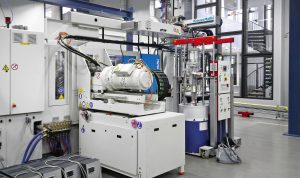
A smart toothpick made of LSR
Canadian Plastics
Plastics ProcessesEasyPick toothpicks from TePe are produced on CXL 160 SilcoSet machines from KraussMaffei.

Photo Credit: TePe
Toothpicks are old technology but that doesn’t mean they don’t evolve over time.
Case in point: TePe, a Swedish oral hygiene products maker in business since 1965, recently introduced the EasyPick, a two-component silicone toothpick produced on CXL 160 SilcoSet injection molding machines from KraussMaffei.
Designed for easy, on-the-go use, the EasyPick consists of a 15-gram white mold base body made of polybutylene terephthalate (PBT) with a conical tip and a coloured silicon overlay weighing just under four grams. The bottom, cooled mold-half contains the thermoplastic component, and the molded article produced here is positioned using a LRX linear robot in the top (hot) silicone half. In this process, the thin PBT is centred, but free in the cavity, allowing it to be encapsulated uniformly from all sides.
The CXL160 machines that are used have an all-electric injection unit in L-connection. “Because the daylight was enlarged by 200 millimeters thanks to the modular system, the non-operator side still remains easily accessible,” KraussMaffei officials said in a news release. “The mold clamping platens have also been widened and the maximum mold installation height expanded.”

A look in the production at TePe: The CXL 160 SilcoSet from KraussMaffei. Photo Credit: KraussMaffei
By the time the low-viscosity LSR flows into the evacuated cavity, the corresponding dye pigments have been added to it earlier in the mixing block. “This is always a tricky matter in the reactive process,” KraussMaffei officials said. “The silicone individual components are generally subject to high batch fluctuations and adding too much dye can lead to overmolding, while adding too little can lead to undermolding.”
“It pays to use the APC plus machine function for non-thermoplastics,” KraussMaffei continued. “Based on the melt viscosity and stored material parameters, such as compression, it adapts the changeover point in each individual cycle. The result is extremely high shot weight consistency – an important criterion for high-precision articles in particular.”
